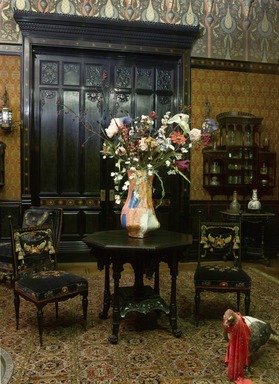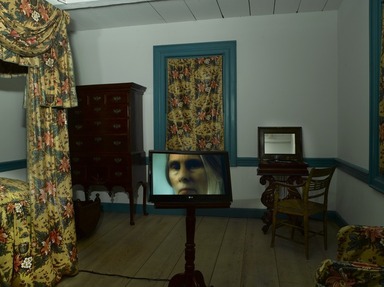

Playing House, February 24, 2012 through August 26, 2012 (Image: DIG_E_2012_Playing_House_Canes_Acres_Plantation_PS6.jpg Brooklyn Museum. (Photo: Sarah DeSantis) photograph, 2012)

Playing House, February 24, 2012 through August 26, 2012 (Image: DIG_E_2012_Playing_House_Cupola_House_Hall_PS4.jpg Brooklyn Museum. (Photo: Sarah DeSantis) photograph, 2012)

Playing House, February 24, 2012 through August 26, 2012 (Image: DIG_E_2012_Playing_House_Joseph_Russell_House_PS4.jpg Brooklyn Museum. (Photo: Sarah DeSantis) photograph, 2012)

Playing House, February 24, 2012 through August 26, 2012 (Image: DIG_E_2012_Playing_House_Milligan_House_view1_PS4.jpg Brooklyn Museum. (Photo: Sarah DeSantis) photograph, 2012)

Playing House, February 24, 2012 through August 26, 2012 (Image: DIG_E_2012_Playing_House_Milligan_House_view2_PS4.jpg Brooklyn Museum. (Photo: Sarah DeSantis) photograph, 2012)

Playing House, February 24, 2012 through August 26, 2012 (Image: DIG_E_2012_Playing_House_Moorish_Smoking_Room_PS4.jpg Brooklyn Museum. (Photo: Sarah DeSantis) photograph, 2012)

Playing House, February 24, 2012 through August 26, 2012 (Image: DIG_E_2012_Playing_House_Schenck_House_Bed_Chamber_Mary_Lucier_01_PS4.jpg Brooklyn Museum. (Photo: Sarah DeSantis) photograph, 2012)

Playing House, February 24, 2012 through August 26, 2012 (Image: DIG_E_2012_Playing_House_Schenck_House_Bed_Chamber_Mary_Lucier_02_PS4.jpg Brooklyn Museum. (Photo: Sarah DeSantis) photograph, 2012)

Playing House, February 24, 2012 through August 26, 2012 (Image: DIG_E_2012_Playing_House_Schenck_House_Betty_Woodman_01_PS4.jpg Brooklyn Museum. (Photo: Sarah DeSantis) photograph, 2012)

Playing House, February 24, 2012 through August 26, 2012 (Image: DIG_E_2012_Playing_House_Schenck_House_Betty_Woodman_02_PS4.jpg Brooklyn Museum. (Photo: Sarah DeSantis) photograph, 2012)

Playing House, February 24, 2012 through August 26, 2012 (Image: DIG_E_2012_Playing_House_Schenck_House_Betty_Woodman_03_PS4.jpg Brooklyn Museum. (Photo: Sarah DeSantis) photograph, 2012)

Playing House, February 24, 2012 through August 26, 2012 (Image: DIG_E_2012_Playing_House_Schenck_House_Dining_Room_Mary_Lucier_PS4.jpg Brooklyn Museum. (Photo: Sarah DeSantis) photograph, 2012)

Playing House, February 24, 2012 through August 26, 2012 (Image: DIG_E_2012_Playing_House_Schenck_House_Kitchen_Mary_Lucier_PS4.jpg Brooklyn Museum. (Photo: Sarah DeSantis) photograph, 2012)

Playing House, February 24, 2012 through August 26, 2012 (Image: DIG_E_2012_Playing_House_Schenck_House_Mary_Lucier_PS4.jpg Brooklyn Museum. (Photo: Sarah DeSantis) photograph, 2012)

Playing House, February 24, 2012 through August 26, 2012 (Image: DIG_E_2012_Playing_House_Schenck_House_Parlor_Mary_Lucier_PS4.jpg Brooklyn Museum. (Photo: Sarah DeSantis) photograph, 2012)

Playing House, February 24, 2012 through August 26, 2012 (Image: DIG_E_2012_Playing_House_Schenck_House_view1_edited_PS4.jpg Brooklyn Museum. (Photo: Sarah DeSantis) photograph, 2012)
Playing House
-
January 1, 2012
Brooklyn, NY—Playing House is the first in a series of “activations” that invite artists to place site-specific artworks in the Brooklyn Museum period rooms. These “activations” will forge new connections between the past and the present and will be juxtaposed with the period furnishings in eight of the Museum’s twenty-three rooms. The inaugural exhibition will include works by Ann Agee, Anne Chu, Mary Lucier, and Betty Woodman and will be on view February 24 through August 26, 2012, at the Brooklyn Museum.
The Brooklyn Museum period rooms have been interpreted by curators to illustrate with archeological precision how Americans of various times, economic levels, and geographic locations lived in the past. In Playing House, each artist has selected a group of period rooms to which they will respond with site-specific installations of various media, including ceramics, textiles, paper, and video.
The project originated with Betty Woodman, an internationally recognized ceramicist and sculptor who has been creating artwork for over fifty years. As the original artist selected for the project, Woodman assembled a team of fellow artists who share her interest in the domestic sphere. The four range in age from eighty (Woodman) to fifty (Anne Chu). While consulting with Barry R. Harwood, Curator of Decorative Arts at the Brooklyn Museum, Woodman was inspired to replace the ceramic, pewter, and silver treasures in the cupboard of the elegant dining room of the Cupola House with an array of her own handmade porcelain cups, saucers, and vases. Woodman also stations one of her seldom seen, baroque-inspired bronze benches in the hallway of the Cupola House.
The Cane Acres Plantation room features artwork by Woodman and Anne Chu. In this Southern interior from the late eighteenth century, Woodman sets the fine mahogany dining table with abstract clay pieces suggesting place settings and installs as the centerpiece a large, white ceramic tabletop sculpture in the shape of a letter holder. Chu fills that centerpiece with a delicate floral arrangement fashioned of fabric and other materials. A life-size cloth cardinal decorated with embroidery by Chu will stand sentry at one of the windowed openings to the room. Chu also contributes her mysterious bird and floral forms to two other very different rooms: the Moorish Smoking Room, a vestige of Victorian New York from the former Worsham-Rockefeller House, and the more austere Neoclassical, wood-paneled bedroom of the eighteenth century parlor of the Russell House.
Ann Agee’s placement of products from the “Agee Manufacturing Co.” in the Milligan Parlor and Den is one of the most visible “activations” in Playing House. A brash hand-drawn and stenciled wallpaper depicting the workroom of the fictional company wraps around this upper-middle-class interior, circa 1854–1856. Thus, in bright primary colors, a box of Tide detergent, ceiling pipes, a work sink, an electric fan, and other present-day tools and materials share space with the thick red drapes and gilt surfaces of rooms furnished for refined leisure in the mid-nineteenth century. Agee has also installed a number of “Agee Manufacturing Co.’s” enigmatic products, such as baby-shaped Jell-O molds and white ceramic bidets propped stork-like on thin steel rods.
Mary Lucier is an American artist who has been creating video and installation artworks since the 1970s. She is a descendant of a Dutch Huguenot couple that was among New York’s earliest settlers, and she will create a video installation that comments on the connections between personal and cultural identity. The work includes six videos, some recreations of imagined scenes within the rooms, as well as a selection of hundreds of ancestral pictures donated by other descendants, in the Jan Martense Schenk and Nicholas Schenk Houses. The oldest work of architecture in the Brooklyn Museum’s collection, the red Dutch-style Jan Martense Schenk house was originally built in 1675 in the area at Brooklyn that is now called Mill Basin.
Playing House is organized by Barry R. Harwood, Curator of Decorative Arts, and Eugenie Tsai, John and Barbara Vogelstein Curator of Contemporary Art, Brooklyn Museum. Previous period room “activations” were by Kiki Smith and Yinka Shonibare.
Press Area of Website
View Original

